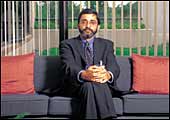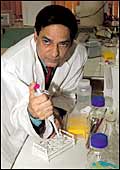|
Circa
2004, the egghead-world is excited about nanotechnology, micro electro
mechanical systems (or MEMS), stem cell research, fuel cells, biotech,
and genomics, though not necessarily in that order. If that's too
much jargon, think regenerative medicine or growing another liver
to replace one damaged by cancer; think atom-sized robots; think
innovative drug delivery systems; think the power to suppress genes
responsible for hereditary diseases; and think pocket-sized power
plants (well, almost). Now, how would you react if we told you that
work-not just ordinary work but bleeding edge stuff-on all these
areas was progressing (and very well indeed, thanks for asking)
in India? Surprised. Well, Indian scientists aren't just participants
in these areas, they are leaders in several, and leaders who are
busy acquiring patents and getting commercial. Not too much noise,
however, is being made about this work at the bleeding edge. Attribute
that to the uniquely Indian trait of understatedness. This may be
the first time you hear about some of these technologies and people,
but mark our words, it won't be the last.
PHARMACEUTICAL RESEARCH
In Quest of the Next Blockbuster
Indian pharma's search for new chemical
entities.
 |
| Ranbaxy's R. Barbhaiya: Talent + Experience
= Success |
It has been 17
months since Rashmi Barbhaiya, a 50-year-old non-resident American,
took up Ranbaxy's offer to head research and development at the
company. Since then, the Bristol-Myers Squibb vet has seen Ranbaxy's
research facility in Gurgaon-its strength now stands at 906- grow
some 40 per cent in size. And Barbhaiya has pulled off an alliance
with Europe's largest drug maker GlaxoSmithKline for the joint development
of new drugs with shared rights in marketing. More alliances, and
some new chemical entities, or new drugs in layspeak, are in the
offing says the researcher.
From high throughput screening (testing multiple
new drug molecules at one go) to research on novel drug delivery
systems to clinical studies, there's nothing multinational pharmaceutical
companies can do that Indian ones cannot. "There is incredible
talent here. Blend it with experience and you have a winning proposition,"
says Barbhaiya. Ranbaxy and Dr. Reddy's are Indian pharma's research
hothouses, but others like Nicholas Piramal and Wockhardt aren't
far behind. And Indian Pharma is yet to leverage the natural advantages
India possesses in in-silico (software-based) drug research.
IMMUNOLOGY
A Cocktail Of Vaccines, Anyone?
India is up to speed on edible, recombinant,
or DNA vaccines.
A typical baby
gets a few tens of shots in the first 18 months of its life. Wouldn't
it be nice if all these could be combined into one safe, side-effect
free cocktail? Delhi-based Panacea Biotec is working on it. Wouldn't
it be even better if your food could be naturally laced with vaccines
without any change in taste? Well, Indian researchers are working
on cultivating tomatoes and muskmelons with in-built cholera and
rabies vaccines. What about a magic vaccine for Acquired Immuno
Deficiency Syndrome (AIDS)? Well India could be the first country
in the world to come out with one; Indian Council of Medical Research,
National aids Control Organisation, and US-based Internal AIDS Vaccine
Initiative are testing one. Can India be vaccine-producer to the
world, an honour that comes with a $8 billion bounty? Maybe; it's
definitely not a long shot.
 |
| PGI Professor S.K. Jindal: Tapping the
network |
TELEMEDICINE
Reaching Out And Beyond
Think tele-everything; it's happening
here.
Remote robotic
surgery may still be the stuff of which science fiction is made.
And standards for storing and transmitting patient-data in digital
form may still be evolving. However Delhi-based All India Institute
of Medical Sciences, Chandigarh-based Post Graduate Institute of
Medical Education and Research (PGI), and Lucknow-based Sanjay Gandhi
Post Graduate Institute have created a network that will enable
doctors at the three to share information and expertise on radiology,
cardiology, and pathology. Soon, the three pioneers hope to extend
it to other institutes with time. Telemedicine is software intensive,
but that is more an opportunity than a problem in coder-rich India.
The Centre for Development of Advanced Computing, which has written
the software for the telemedicine project, is now eyeing overseas
markets. Bravo!
FUEL CELLS
Forget E, H Is For Energy
Pune's NCL may soon have an alternative
to fossil fuels.
No one in India
is developing an environment-friendly car like the Toyota Prius,
but Pune-based National Chemical Laboratory (NCL) is working on
something based on the same principle, fuel cells. The principle
is quite easy to understand: Electrolysis is the process by which
water is broken into its constituents, hydrogen and oxygen, using
an electric charge; the use of hydrogen as a fuel is based on the
premise that when it and oxygen combine to create water, they produce
electricity. NCL began its research into fuel cells three years
ago. Right now, it is addressing the crucial issue of feedstock:
Will the hydrogen be produced at one location and piped (an expensive
proposition), or will it be created on-site (a much more viable
option)? P.S.: The water produced in this process is pure enough
to drink. Surely, that should be a major plus in a pure-water-starved
country like India?
-Priya Srinivasan
 |
| Himalaya's R. Prasad: Taking Ayurveda
global |
NATUROPATHY
The Natural Road To Wellness
Ayurveda makes a resounding comeback.
One of India's
traditional systems of medicine, Ayurveda, goes back a few thousand
years. If it is making a comeback, attribute it to the emergence
of naturopathy on the therapeutic mainstream. And as researchers
grapple with the challenges involved in creating herbal formulations,
marrying Ayurveda with modern science to offer herbs-in-a-capsule
is catching on in India. Ravi Prasad, the Chief Executive Officer
of Himalaya Drug Company, calls this process "active Ayurveda"
and believes this could be India's ticket to the big time. Ranbaxy
Laboratories and Panacea Biotec are converging on the opportunity
too. The latter has even filed patents for a herbal diabetes drug.
The estimated opportunity: $5 trillion (Rs 23,000,000 crore) by
2050.
 |
| CSIO's L.M. Bharadwaj: Small is beautiful |
NANOTECH
Rebuilding The World: Atom By Atom
Smallest is beautiful in India's research
labs.
And to think that
the biomolecular Electronics and Nanotechnology division of the
Central Scientific Instruments Organisation that Dr. Lalit M. Bharadwaj
heads was founded just over a year ago. Today, financial institutions,
companies, Ph.D students, and MNCs are falling over themselves to
buy into his vision. "My Ph.D students receive offers of scholarship
from Berkeley (the University of California)," gloats Bharadwaj.
Ones they refuse, naturally, for the division is one of the very
few in the world working on DNA-processors and storage devices.
"A single gram of DNA can store more information than a trillion
CDs," says Bharadwaj whose team has filed a patent for a software
that can convert any text or image into a DNA sequence.
 |
| CSIO's R.P. Bajpai: Architecting a micro-diagnostics
first |
MICRO ELECTRO MECHANICAL
SYSTEMS
Waiter, There's A MEMS In My Soup...
... and it probably has a higher IQ than
you, sir.
In the beginning
was the mainframe and the mainframe was with God and the mainframe
was God. Then came, in quick succession, the desktop, the laptop,
the palmtop, and the personal digital assistant. Today's researchers
are working at the level of a micron (one-millionth of a metre)
to create micro electro mechanical systems (or MEMS). Think of these
as fully-functional robots on a microchip with all the capabilities
of sensors, actuators, and processors and which will, in all likelihood,
be at the core of tomorrow's communication, entertainment, computing,
even medical devices. For instance, an MEMS-on-a-pill could collect
data, visual and pathological, as it passes through a patient's
intestine. Within the next year, the Central Scientific Instruments
Organisation (CSIO) will boast a prototype of an MEMS-based tuberculosis
diagnostic kit that will reduce the time taken to diagnose the disease
from a few weeks to a few hours. Next step: diagnostic kits for
malaria, hepatitis, and aids. "We are racing the world to manage
a first," says R.P. Bajpai, Director, CSIO. And India's Council
of Scientific and Industrial Research, Defence Research and Development
Organisation, Department of Science and Technology, Indian Space
Research Organisation, and Department of Information Technology
have put up Rs 75 crore to fund a National Programme on Smart Materials
under which a clutch of institutions is working on MEMS applications.
The size of the global MEMS market is estimated to touch $10 billion
(Rs 46,000 crore) by 2006.
REGENERATIVE MEDICINE
To Make In One's Own Likeness
Stem-cell based therapy is actually happening
in India.
 |
| Prasad's D. Balasubramanian: Stem cell
pioneer |
Stem cells, especially
those derived from embryos have the ability to evolve into any kind
of cell, a skin cell, a heart cell or a kidney cell. Research into
stem cells could hold the key to regenerative medicine. Of the 10
organisations recognised as a source of stem cells by the US' National
Institute of Health, two, Reliance Life Sciences (Mumbai), and National
Centre for Biological Sciences (Bangalore) are in India. Even more
significantly, India is among the pioneers in stem cell-based therapy.
The Hyderabad-based L.V. Prasad Eye Institute uses stem cell technology
to reconstruct corneas. "We have the first large scale successful
trial of adult stem cell technology on humans," says Dr. D.
Balasubramanian, the director of research at the hospital. There's
more: at Delhi's Maulana Azad Medical College, Dr. B.G. Matapurkar
has worked out a technique of regenerating organs and tissues from
stem cells. And Mumbai's Asian Heart Institute and research Centre
is developing therapies using stem cells. Sensing the opportunity
that the emerging area presents for the country, President A.P.J.
Abdul Kalam has favoured the launch of a national stem cell research
programme even as the rest of the world debates the ethics of using
embryonic stem cells. We were among the first to get into the game.
We could finish first in the race.
|
